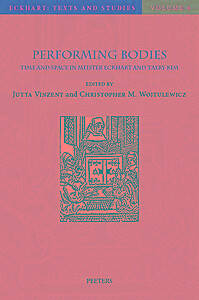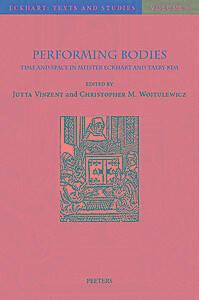
- Afhalen na 1 uur in een winkel met voorraad
- Gratis thuislevering in België vanaf € 30
- Ruim aanbod met 7 miljoen producten
- Afhalen na 1 uur in een winkel met voorraad
- Gratis thuislevering in België vanaf € 30
- Ruim aanbod met 7 miljoen producten
Zoeken
Performing Bodies
Time and Space in Meister Eckhart and Taery Kim
€ 72,00
+ 144 punten
Omschrijving
What is time, what is space and how do they relate to each other? Even to pose these questions is to presume their existence, says Meister Eckhart in his Commentary on Exodus, from where he then develops his own view on the subject. Although far from having become mainstream, his definition of time as presentiality and space as non-categorical creativity had an enormous influence throughout history, particularly in the arts. In this thematic volume the contributors explore the concepts of time and space in Eckhart's thought, situating these historically, philosophically, theologically, and culturally, whilst focusing on their interpretation in art works, particularly by the American-Korean performance and video artist Taery Kim (b. 1988) who refers explicitely to Eckhart. Kim advances the questions 'what is time?' and 'what is space?' as embodied questions in her performances and video installations, thus exploring Eckhart and inquiring into the ways we can think about our relationships, as embodied subjects, to the vagrancies and bindings of time and space now. Drawing together artists, art historians, theologians, and philosophers, as well as building on existing scholarship, this volume provides the first lengthy discussion of spatio-temporality in Eckhart's writings, highlighting Eckhart's relationship to performance art, and the works of Kim.
Specificaties
Betrokkenen
- Uitgeverij:
Inhoud
- Aantal bladzijden:
- 292
- Taal:
- Engels
- Reeks:
- Reeksnummer:
- nr. 6
Eigenschappen
- Productcode (EAN):
- 9789042933316
- Verschijningsdatum:
- 22/01/2016
- Uitvoering:
- Hardcover
- Formaat:
- Genaaid
- Afmetingen:
- 168 mm x 246 mm
- Gewicht:
- 798 g

Alleen bij Standaard Boekhandel
+ 144 punten op je klantenkaart van Standaard Boekhandel
Beoordelingen
We publiceren alleen reviews die voldoen aan de voorwaarden voor reviews. Bekijk onze voorwaarden voor reviews.










